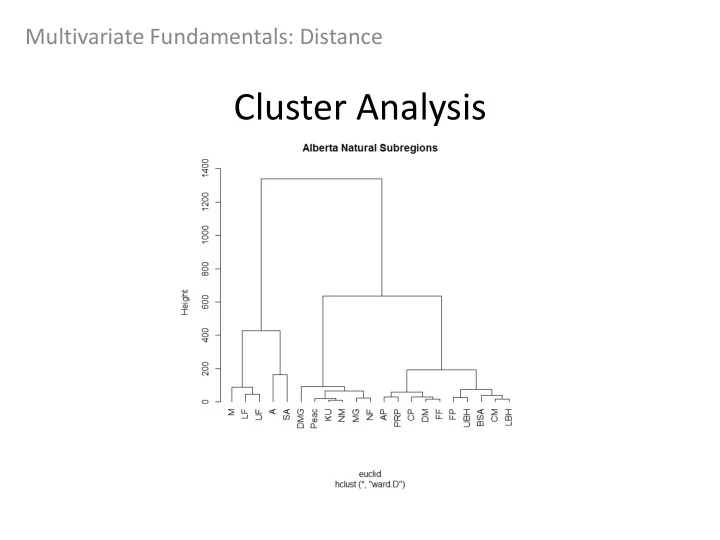

Multivariate Fundamentals: Distance Cluster Analysis
Objective: Group data points into classes of similar points based on a series of variables Useful to find the true groups that are assumed to really exist, BUT if the analysis generates unexpected groupings it could inform new relationships you might want to investigate Also useful for data reduction by finding which data points are similar and allow for subsampling of the original dataset without losing information Alfred Louis Kroeber (1876-1961)
The math behind cluster analysis A B C D … A 0 1.8 0.6 3.0 Once we calculate a distance matrix between points we B 1.8 0 2.5 3.3 C 0.6 2.5 0 2.2 use that information to build a tree D 3.0 3.3 2.2 0 … Ordination – visualizes the information in the distance calculations The result of a cluster analysis is a tree or dendrogram 0.6 1.8 4 2.5 3.0 2.2 3 3.3 distance 2 1 If distances are not equal between points we D A C can draw a “hanging tree” to illustrate B 0 distances
Building trees & creating groups 1. Nearest Neighbour Method – create groups by starting with the smallest distances and build branches In effect we keep asking data matrix “Which plot is my nearest neighbour ?” to add branches 2. Centroid Method – creates a group based on smallest distance to group centroid rather than group member First creates a group based on small distance then uses the centroid of that group to find which additional points belong in the same group 3. Wards Method – creates groups such that variance is minimized within clusters Looks for spherical clusters The process starts with all points in individual clusters (bottom up) and the process repeatedly merges a pair of clusters such that when merged there is a minimum increase in total within-cluster variance This process continues until a single group including all points (the top of the tree) is defined
Building trees & creating groups One of the problems with Cluster Analysis is that different methods may produce different results – generally no accepted best method Good News : If your data really has clear groups all methods will find them and give you similar results Therefore it is best to try multiple algorithms and see what groups logically make sense If you have a dummy dataset with pre-determined groups you can use it to see which algorithm best recreates what you expect
Cluster analysis in R Distance matrix of your data rows based on your predictor variables You need to calculate this before running the cluster analysis We create distance CA in R: hclust(distMatrix,method) (stats package) matrices in Lab 5 What type of algorithm should be used to cluster points and define groups " ward.D " = Ward’s minimum variance method " ward.D2" = Ward’s minimum variance method – however dissimilarities are squared before clustering "single" = Nearest neighbours method "complete" = distance between two clusters is defined as the maximum distance between an observation in one cluster and an observation in the other cluster "average" = distance between two clusters is defined as the mean distance between an observation in one cluster and an observation in the other cluster "mcquitty " = when two clusters are be joined, the distance of the new cluster to any other cluster is calculated as the average of the distances of the soon to be joined clusters to that other cluster "median" = uses group median "centroid" = uses group centroid
Cluster analysis in R From the output plot we can compare the groups cluster analysis has generated Each collection of branches could be considered a group It is up to you to decide how far down the tree you want to specify your groups We want small distances and groups that logically make sense
Recommend
More recommend